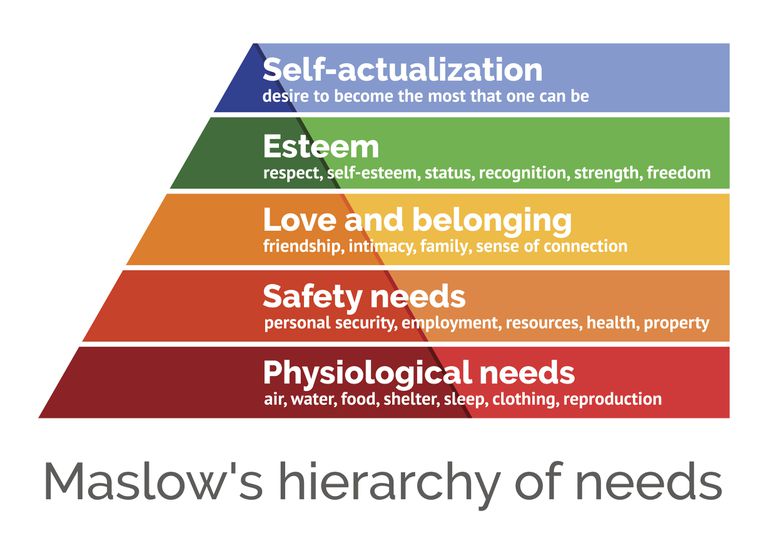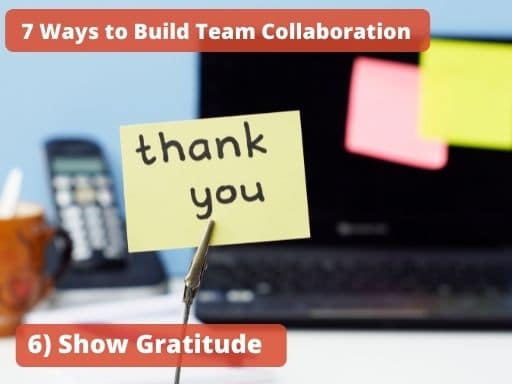Team Cooperation-7 Valuable Ways to Build Team Collaboration at Work

As a review, the first phase was to focus on your organization’s goals to create a shared vision for your team. When your team focuses on a common goal and sees the big picture, a collaborative environment will begin to form. The second step is to establish trust and effective communication within your team. Next, we showed you how to reduce conflicts among team members.
You will have a difficult time motivating your team if they don’t trust you or each other. In addition, you will also have a difficult time getting others to cooperate if there is a conflict. So first, make sure to spend some time building more of a team culture using the tips from the other two posts.
To Gain Team Cooperation, You First Have to Know Motivates Each Member of the Team.

Over the years, psychologists have argued about the levels in the hierarchy. The actual levels and order of each level aren’t as important to this discussion as the agreement that we have a hierarchy, though. As leaders, we have to know the hierarchy of our team members and what level they are currently at. For instance, one team member may have been entirely motivated by recognition and appreciation. However, if this person’s child gets sick, the priorities change in an instant.
The point is that the tips below are time-tested ways to build a cooperative team. If the trust is high and conflicts are low, these tips should work very effectively. So, if you find some members of your team to not be as cooperative, it might be that something has happened to move them to a lower level in Maslow’s Hierarchy.
Your goal as the leader of your group of employees is to build a cooperative workplace where staff members are consistently at the highest level of this hierarchy.
7 Valuable Ways to Build Team Cooperation and Team Collaboration.
If you recall in phase one, building trust, I mentioned that constructive criticism is often used to create a behavior change in others. However, criticism will often harm an individual performance. In this session, though, we will cover seven things that you can do to gain cooperation that work much better than constructive criticism. These seven cooperation skills are a great way to get your team members to work together and support each other. In effect, you create a culture of collaborative leadership by focusing on these skills.
- Acknowledge the Importance of Other People.
- Show Enthusiasm and Energy.
- Encourage and Facilitate Two-Way Conversations.
- Ask Other People’s Opinions.
- Ask questions Instead of Giving Orders
- Show Gratitude When Others Cooperate with You.
- Freely Give Strength-Centered Compliments.
For additional details about the difference between constructive criticism and destructive criticism, click here.
(1) Acknowledge the Importance of Other People.

When he gave it to her, she was a little surprised. He was the first person in years to treat her like an equal in the office. When he came back to my class the next week, he told us that she had taken the sticky note off the can and stuck it under the plastic protector that covered her desk so that she could see it every day.
I saw this man a couple of years later and asked him about the sales assistant. He told me that she is still there and still doing a fabulous job. He said, though, that she now has over a dozen of the sticky notes on her desk. She keeps every one.
Great leaders use this aspect of human nature to make people feel important. One way to be a great leader is to find some way every day to make the people around you feel important.
(2) To Build Team Cooperation, the Leader Must Show Enthusiasm and Energy.

Have you ever noticed that the most successful people are the early risers? Ben Franklin called this group of people the “Six O’clock Club.”
Franklin spent the first hour of his day planning the events of his day and reading. He often claimed that he did his best work in the first hour of his day.
How does this relate to raising your own energy level? We have a choice every morning when we wake up. Do I want to hit the snooze bar a few times, or do I want to put some energy and enthusiasm into my day?
When you must do a dirty job, jump in with lots of enthusiasm and gusto. When you have a challenging project that no one else wants to do, you can use that project as an opportunity to set an example for your team. A good team player will often watch the team leader. Each individual player will have just a little less enthusiasm than the team leader. So one of the surest ways to create better teamwork and improve group dynamics is to increase your enthusiasm as the leader.
Everyone wants to be around people who are going somewhere. The person who sets out to enthusiastically get to the next level will attract tons of followers. Enthusiasm is contagious.
So, raise your energy level. Your positive attitude will be contagious and group performance will improve.
(3) Encourage and Facilitate Two-Way Conversations.

Herb Peterson was a McDonald’s franchise holder in 1972 who absolutely loved Eggs Benedict. He tinkered around in his garage and invented a Teflon coated ring that would allow him to make eggs on the hamburger grill. At that time, McDonald’s was just a hamburger place without a lot of additional items. So, when he took the idea to the McDonald’s headquarters in Chicago, I’m sure it sounded ridiculous. However, that dialogue between Peterson and the executives was the beginning of the Egg McMuffin.
Today, it’s estimated that McDonald’s sells about $4 billion worth of breakfast per year.
These dialogues that we create with the people who work for us can provide us with valuable information – both good and bad. This information is critical in helping us make solid decisions in the marketplace.
(4) Ask Other People’s Opinions to Build a Cooperative and Effective Team.

Since he was in a bind, he called all of the foremen together and asked what they thought they could do to fix the problem. One of them asked to borrow the crane and a Skill saw and beveled the rocks by hand. The work was done so well that the architect sent a picture of the building to be judged for an award from the American Institute of Architects.
When we are under the gun, most of us want to take control and begin to order people around. Since time is short, we want to quicken the pace by just telling people what to do instead of asking them their opinion. When we do this, though, we are often missing an opportunity to gain great insights from the people who are on the front line. So, to develop team cooperation, ask the opinion of the other person.
(5) Build Team Collaboration by Asking Questions Instead of Giving Orders.

typically were either taking a long time to implement or had to be reworked.
His boss realized that there was a problem. He pulled him into his office and explained to David that his crew resented being ordered around. The boss asked him to begin to ask for the advice of his team rather than ordering them around.
After the meeting, David began drawing up alternative plans and bringing them to the crew. He would ask their opinion, and nine times out of ten his original idea was the popular choice. The other 10% of the time, he
learned valuable insights about design and engineering. These were things that would have taken years to learn in school. Rework dropped dramatically.
So to build a cooperative and effective team, ask the experts on your team for their opinions.
(6) Show Gratitude When Others Cooperate with You.

One of my clients owned a real estate appraisal company. His staff was compensated for the number of appraisals that they completed each week. After a few years, he noticed that the number of appraisals had increased, but the quality was suffering. In fact, he was personally spending a great deal of time rechecking and correcting flawed documents.
One day at a staff meeting, he publicly complimented one of the appraisers who had consistently provided flawless
documents. The owner noticed that in the next few weeks, her work actually improved even more. As a side benefit, at the same time, the overall quality of everyone’s documents went up as well. He continued to compliment the improvements, and quality continued to rise.
What he realized was that for years, he had taken the people that worked for him for granted. He assumed that their paycheck was appreciative enough. As he began to show each person how much he appreciated them, the quality of their work improved, and his particular job as the president of the company became easier and easier as well.
So, after you gain team cooperation, show sincere gratitude.
(7) Freely Give Strength-Centered Compliments.

In the business world today, compliments are very rare. We are busy. We also want to make sure that any positive comment isn’t taken the wrong way. As a result, we miss opportunities to reinforce positive behaviors. A good sincere compliment can do just that. It can help you anchor the positive behavior that you see in your team.
My suggestion is to look for something positive that each one of your direct reports has done, every-single-day. Then, tell the person what you like about what the person did. Tell the person how much that behavior helps the bottom line.
You will see the person’s confidence grow, and you will both good about yourselves.
Team Cooperation and a Collaborative Work Environment Leads to Higher Performance and Greater Success.
At the end of the day, the main takeaway is that cooperative groups improve business success. When you create a corporate culture of teamwork, the success of your team is almost guaranteed. A team’s success is higher and team performance improves when group members cooperate well. So, if you want to unleash the full potential of your group, practice each of these seven principles on a daily basis.
Want to Develop a Collaborative Culture within Your Workplace Team?
We offer a number of different team workshops to improve communication skills and help improve work environments. Complete the form below for details about the Creating a Team Culture workshop. This program is one of the best ways to build group cooperation, develop good communication within a healthy team, and improve team dynamics.
